India from the Moguls
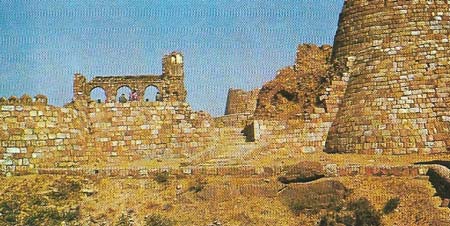
Figure 1. The ruins of the fortress and city at Tughlukabad, near Delhi, are an example of the feckless manner in which Indian cities were made and unmade by rulers who sought to commemorate themselves by building new capitals. Constructed between 1321 and 1323, Tughlukabad was soon abandoned by Muhammad Tughluk Shah in favor of Deogir, ostensibly because of bad water.
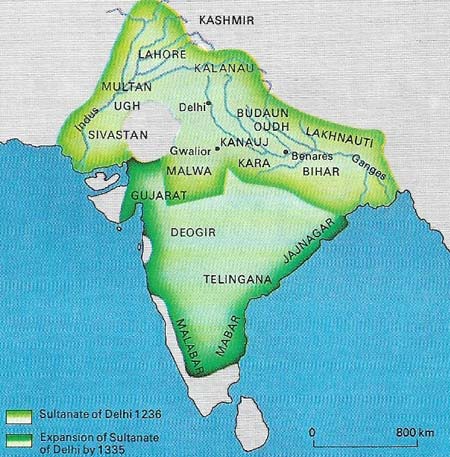
Figure 2. The Sultanate of Delhi at the death of Iltumish (1236) and,100 years later, under Muhammad-bin-Tughluk (1325–1351), when it reached its greatest extent, are shown on the map. It indicates that Muslim dynasties had dominated northern India for centuries before the Moguls and had made attempts apparently, only temporarily successfully, to dominate the Deccan and the south of India.
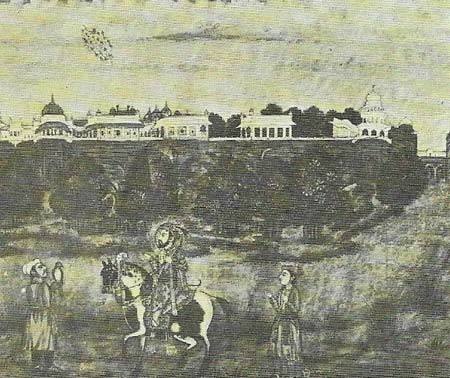
Figure 3. The Red Fort at Delhi, built by Shah Jehan (1592–1666), was surrounded by massive red sandstone walls 22.8 meters (75 feet) high and enclosed a complex of palaces, gardens, military barracks and other buildings. The fort, like many other masterpieces of tis reign, including the Taj Mahal, illustrates the splendor of Mogul rule in India.
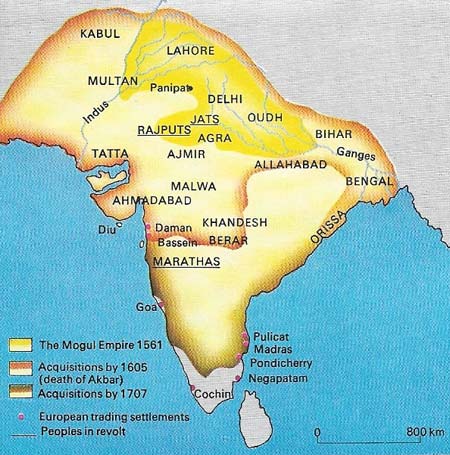
Figure 4. The rise of the Mogul Empire and the early signs of its decline are indicated on the map. By 1561 Akbar had created a unified Mogul Empire in the north of India; by 1707 when Aurungzebe died, the Mogul Empire had reached its utmost limits. But the Rajputs, Jats, and Marathas were already in revolt and the European seaborne powers, who were to be the heirs of the Moguls, occupied the coast.
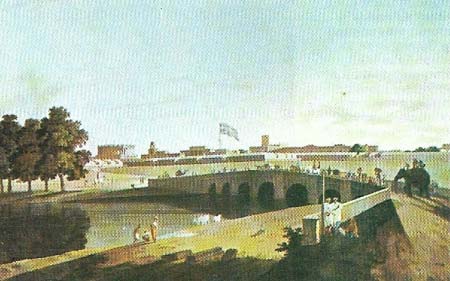
Figure 5. The English settlement at Fort St George in Madras was one of the earliest in India, set up in 1639. The struggle with the French for mastery centered upon the south and the fort was crucial.
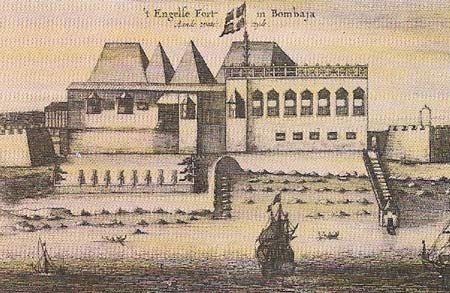
Figure 6. Bombay was ceded by Portugal to the English in 1661 and granted to the East India Company in 1668. Its fort helped to defend English commercial interests located on the west coast of India.
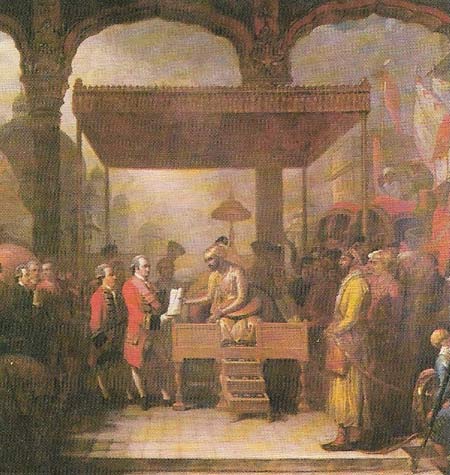
Figure 7. In 1765 Shah Alam made his grant of the diwani – the right to collect land revenue – to Clive, by then the real master of Bengal. The fact that the Mogul, although politically impotent by this time, was still seen as the source of legitimacy in ratifying the company's authority in Bengal, shows the conservatism of Indian politics; it is also indicative of British reluctance to move from trade to dominion that Clive did not demand more power.
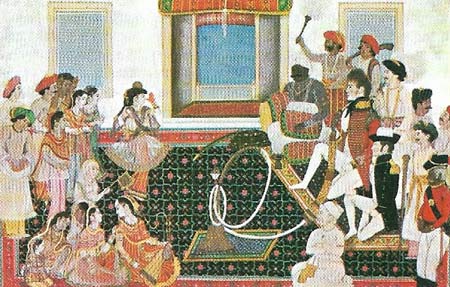
Figure 8. After the Afghan defeat of the Marathas at Panipat (1761) Mahadaji Sindhia (1727–1794), a bluff but literate soldier of fortune, built a large empire in Hindustan. Acting nominally as the soldier of the peshwa (sovereign), he became the master of the Mogul ruler, Shah Alam, and the "actual sovereign of Hindustan from the Sutlej to Agra, the conqueror of the princes of Rajputana, the commander of an army". But although he modernized the Maratha armies, giving them artillery and recruiting Muslim and Jat soldiers and European officers in his service (one of whom he is entertaining here), his power was fragile because his domains lacked the resources to support his armies.
In 1192 Muhammad of Ghur destroyed the Rajput princes at Tarain. In the next ten years the Muslims overran the Ganges plains and founded the Sultanate of Delhi (1206). This marked the beginning of Islam's long dominance over Hindustan (northern India) which survived into the 1700s and created an entity that was distinct in the Islamic world.
The three centuries that followed saw the rise and fall of dynasties – the Turco-Afghans, Khaljis, Tughluks, Sayyids and Lodis – under which the Delhi Empire sometimes expanded as far as the Deccan and the south (as it did under the megalomaniac Alaudin Kalji, or under Muhammad-bin-Tughluk the greatest of the sultans) and sometimes contracted into the narrow regions around Delhi and Agra (as it did under the Lodis) (Figure 2).
Thee regions continued to challenge the center; invasions from the north (of which Timur's sack of Delhi in 1398 was the most ferocious example) still threatened the empires, and Delhi remained unable to dominate the Deccan.
Two new forces, however, were to alter the old patterns: Mogul rule and European expansion. In 1526 Babur (1483–1530), driven from his mountain stronghold in Fir-ghana, crushed the Lodis at Panipat and established the Moguls in Delhi. In 1498 the Portuguese explorer Vasco da Gama sailed into Calicut, the precursor of other seaborne powers from Europe who in time were to be the heirs of the Mogul.
Mogul Empire
The great Mogul rulers – Babur, Humayun, Sher Shah, and, above all, Akbar and Aurungzebe – brought more of India under one empire than any ruler since the time of Ashoka in the third century BC and gave it a more sophisticated administration than it had ever possessed. But the Great Mogor (Mogul), sitting on his peacock throne, surrounded by his great entourage of courtiers, concubines and slaves, his vast numbers of elephants and camels, and backed by his 200,000 cavalry, had built an empire on a fragile base.
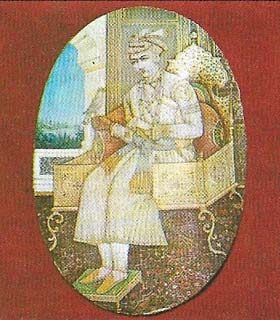 |
| Akbar (r. 1556–1605), the most celebrated Mogul emperor, was the almost exact contemporary of Queen Elizabeth I. He vastly expanded the Mogul's territories, gave them an efficient system of government and tried to encourage new sources of work. In his effort to conciliate his Hindu subjects and to stamp out Muslim bigotry, the emperor tried, but without success, to create for India a new religion reconciling the different beliefs. |
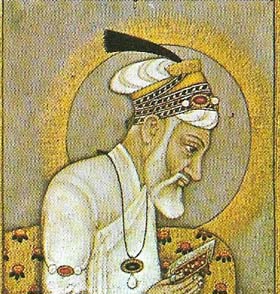 |
| Under Aurungzebe (r. 1659–1707), the MogulEmpire reached its greatest extent: from Kabul to the Cauvery. But the empire he bequeathed did not survive much beyond the five years of his son's reign. The seeds of disruption, always present, were germinated by his religious intolerance; he alienated the Rajputs, the military prop of the empire; at great cost he conquered, but failed to integrate, the Deccan; he neglected Hindistan and fought the Marathas in the south. |
Mogul rule was the rule of foreigners and it was expensive. Built by conquest, it could not be sustained by force alone. Despite all the trappings of imperial power, the army and the centrally controlled military bureaucrats (the mansabdars), the Moguls were forced to come to terms with their Indian subjects. This meant they had to give reasonable freedom to the magnates who actually controlled the land. They had to tolerate Hinduism and above all they had to avoid meddling too much in local affairs. All this qualified the notion of Mogul power – more overrule than real empire – and helps to explain the decline of the Mogul Empire (Figure 6).
The problem of revenue
Like all land empires in pre-modern times, the fundamental difficulty the Mogul rulers faced was how to raise revenues from limited sources, while retaining the cooperation of local notables, the zomindars. One obvious device was to extend the empire but, as Aurungzebe discovered, more conquest meant more expense. Another was to try to extract more land revenue from their subjects, but in the end the Moguls lost the cooperation of the local notables, who were squeezed from above and resisted by the peasantry below. These inherent difficulties were made worse by Aurungzebe's religious intolerance, which alienated the Rajput allies and confirmed the Marathas in their hostility. A sequence of ineffectual successors after Aurungzebe reduced the throne at Delhi to the plaything of factions; more invasions from the north culminated in Nader Shah's sack of Delhi in 1739.
Rise of the East India Company
With the collapse of Mogul rule, India was parcelled out among a set of virtually independent "country" powers – Bengal and Oudh under the Nawabs, Mysore under the Muslim dynasty of an adventurer, Hyderabad under the Nizam and the Maratha confederacy marauding throughout India from its western base.
This was the background to the territorial rise of the British-owned East India Company. The company had gone to India to trade not conquer. Throughout the eighteenth century its directors protested that commerce, not dominion, was their aim. But by the mid-eighteenth century the British, long established in their factories at Calcutta, Madras and Bombay (Figure 6), had a trade (mainly in Indian cotton goods) that was worth protecting both against the smaller French company and against Indian disruption (Figure 5).
When Britain and France fought in Europe, the companies in India could not stay neutral. Faced by a more powerful English company, Joseph Francois Dupleix (1697–1763) of the French East India Council decided, during the Austrian War of Succession, to improve the odds by using Indian allies against his rival.
The English soon adopted the French tactic. Robert Clive (1725–1774) used it to win the Battle of Plassey (1757) and thereby gain Bengal. Dupleix's idea of using Indian resources to pay for European expansion gave Britain the richest province of India and set her firmly on the road to dominion (Figure 7).
By the time William Pitt (1759–1806) and Henry Dundas (1742–1811) began to think of an Indian Empire as part of the swing eastwards of British expansion, the East India Company had already become the heir of the Moguls.
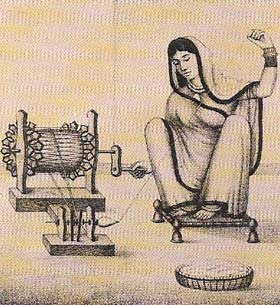 |
| The East India Company's fortunes in the late 17th and 18th centuries were built upon the export of hand loom cottons whose thread was spun in villages throughout India, sometimes with the aid of the gharkha, or spinning wheel, illustrated here. The 19th century saw the decline of village spinning and weaving, and India became the largest market for Lancashire's cotton goods. In the 20th century Gandhi revived the hand loom. |
 ,are,,,
,are,,,